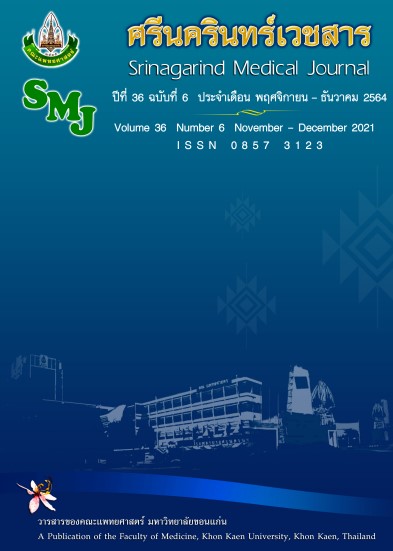Application of Altitude Training in Healthy Subjects, Athletes, and Some Patients
Keywords:
Keyword: altitude; hypoxia; training; performanceAbstract
บทคัดย่อ
ประชากรส่วนใหญ่ตั้งบ้านเรือนอาศัยอยู่บนพื้นที่ราบที่มีความสูงใกล้เคียงระดับน้ำทะเลซึ่งมีความดันบรรยากาศและความเข้มข้นของออกซิเจนพอเหมาะกับการทำงานของร่างกายมนุษย์ บนพื้นที่สูงปริมาตรอากาศต่าง ๆ จะขยายตัวเนื่องจากความดันบรรยากาศลดลงจึงส่งผลให้ความเข้มข้นของออกซิเจนลดลงและสมรรถภาพทางกายลดลงด้วย นอกจากนี้ในปี ค.ศ.1968 การแข่งขันกีฬาโอลิมปิกได้จัดขึ้นที่ประเทศเมกซิโกซึ่งตั้งอยู่บนพื้นที่สูงเหนือระดับน้ำทะเล 2,300 เมตร การแข่งขันครั้งนี้ทำให้ในแวดวงวิทยาศาสตร์การออกกำลังกายและกีฬามีความสนใจมากขึ้นเกี่ยวกับผลของการฝึกซ้อมบนพื้นที่สูงเพื่อเพิ่มสมรรถภาพในนักกีฬาเมื่อกลับมาสู่พื้นที่ราบใกล้ระดับน้ำทะเล เนื่องจากในเวลานั้นพบว่านักกีฬาประเภททนทานจากประเทศที่อยู่บนพื้นที่สูง ได้แก่ ประเทศเคนย่า และเอธิโอเปียได้รับเหรียญรางวัลมากกว่าเมื่อเทียบกับประเทศที่มีที่ตั้งอยู่พื้นที่ราบใกล้ระดับน้ำทะเล โดยตลอดหลายปีที่ผ่านมา นักวิทยาศาสตร์การกีฬาได้พยายามหาคำตอบเกี่ยวกับการฝึกบนพื้นที่สูงว่ามีผลต่อการทำงานของร่างกายอย่างไรและผลกระทบดังกล่าวส่งผลต่อสมรรถภาพของนักกีฬาหรือไม่ อย่างไร แต่เนื่องด้วยการฝึกซ้อมอาจมีข้อจำกัดอันเกิดจากการเดินทางขึ้นไปฝึกบนพื้นที่สูงจริงในปัจจุบันนักวิทยาศาสตร์จึงได้คิดค้นเครื่องจำลองบรรยากาศบนที่สูงขึ้น เพื่อหลีกเลี่ยงข้อจำกัดดังกล่าวในบทความนี้จะกล่าวถึงความรู้ความเข้าใจในปัจจุบันเกี่ยวกับการปรับตัวทางสรีรวิทยาต่อการฝึกบนพื้นที่สูงจริงและในสภาวะจำลอง ซึ่งเป็นกลยุทธใหม่ที่ได้ถูกนำมาใช้และศึกษาวิจัยในการเพิ่มสมรรถภาพและส่งเสริมสุขภาพในประชากรหลายๆกลุ่มที่มีระดับสมรรถภาพทางกายแตกต่างกัน เช่น กลุ่มนักกีฬา คนสุขภาพดีทั่วไป ตลอดจนในผู้ป่วยโรคเรื้อรังต่าง ๆ ในบทความนี้จะกล่าวถึงการฝึกบนที่สูงรูปแบบใหม่ซึ่งอาจเป็นทางเลือกหนึ่งในการเตรียมนักกีฬาสำหรับการแข่งขัน ในการส่งเสริมสุขภาพสำหรับคนทั่วไป รวมทั้งการป้องกันและรักษาโรคเรื้อรังบางอย่าง
คำสำคัญ: พื้นที่สูง; ขาดออกซิเจน; การฝึก; สมรรถนะ
Abstract
Although most of the world’s population live at or near sea level which has optimal atmospheric pressure and oxygen concentration for the human body function, some people habitat on a high plateau or mountain located in different parts of the world. At altitude, the air volume expands due to the lowering of atmospheric pressure, which eventually results in the reduction of oxygen concentration. According to 1968 Olympic Games which was held in Mexico City (located at 2,300 m above sea level), only endurance athletes from high altitude countries like Kenya and Ethiopia who showed superior performance with higher number of Olympic medal winners when compared to sea level countries. Since then, the exercise and sports scientist have shown increased interests in the use of altitude training to improve sea level performance in athletes. Many sport scientists have tried to answer the question why and how altitude affects the human body in an attempt to gain more knowledge about the use of altitude training for performance enhancement. As a result, the simulated altitude devices have been developed in order to avoid the inconvenience of real altitude sojourns. This article describes the current understanding of physiological adaptations to both real and simulated altitude training studies. Several approaches have been developed and used to improve performance or health in different groups of subjects such as athletes, healthy, and patients. In this review, a new altitude training modality has been introduced and may be used as an alternative strategy to prepare athletes for competitions, to improve health in general people and also to prevent or treat in some diseases.
Keyword: altitude; hypoxia; training; performance




